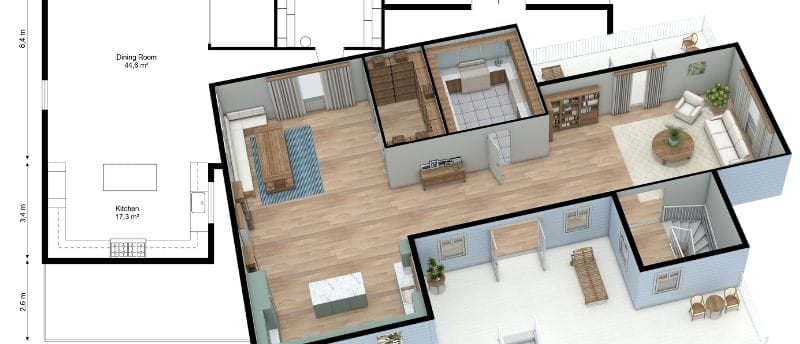Stylish and Functional: Simple Interior Decoration Ideas for Small Spaces


Understanding the Challenge of Small Spaces
Decorating small spaces presents a unique set of challenges that require thoughtful consideration and strategic planning. Limited square footage compels individuals to rethink traditional design choices and find ways to maximize functionality without compromising style. One of the most significant hurdles is the quest for multi-functional furniture, which serves to optimize available space while providing necessary utility. For instance, a sofa bed or an ottoman with storage can revolutionize how a small living area is utilized, proving that practicality and aesthetics can coexist beautifully.
Color schemes play a pivotal role in the decoration of compact areas as well. Lighter hues tend to reflect light, creating an illusion of more space, while darker shades can make a room feel cozier but potentially smaller. Choosing the right palette not only enhances the room's luminosity but also affects the mood and comfort levels experienced by its inhabitants. Nullifying common misconceptions about colors in small spaces is essential; for example, many believe that white walls are the only solution. A well-selected combination of light pastels or subdued tones can also achieve a sense of openness and dynamism.
Despite the potential for creative solutions, many homeowners inadvertently make mistakes that can detract from their space’s appeal. Overcrowding a small area with oversized furniture or excessive decorative items can lead to a cramped atmosphere, counteracting any efforts to create a serene environment. Additionally, neglecting to plan the layout in advance often results in inefficient use of space. Therefore, taking the time to strategize before embarking on a decoration project is crucial for yielding satisfying results in small interiors. Understanding these challenges is the first step toward transforming a petite space into a stylish and functional haven.
Color Palettes That Expand Your Space
Color plays a significant role in interior design, particularly in small spaces where the right palette can dramatically influence the perception of size and openness. Light and neutral colors, such as whites, beiges, and soft pastels, are known to make a room feel more expansive. These hues reflect light, creating a bright environment that gives the illusion of added space. When selecting a color palette for small interiors, it is advisable to choose one that maintains a consistent flow throughout the area. This seamless approach can enhance the overall perception of spaciousness and avoid a cramped feel.
In addition to a balanced base of neutral colors, incorporating accent colors can add depth and character to the setting. These accents can be introduced through accessories like cushions, rugs, or artwork, strategically placed to promote visual interest without overwhelming the space. Shades such as navy blue, forest green, or even vibrant yellows can serve as effective accents when paired wisely with lighter tones. Utilizing these bold colors in small quantities not only helps energize the environment but also maintains a sense of openness.
To further enhance the spatial perception, consider employing paint techniques that offer visual tricks. For instance, vertical stripes painted on walls can give the illusion of height, drawing the eye upwards and making ceilings seem taller. Conversely, an ombre effect—where colors fade from light at the bottom to darker shades at the top—can create a sense of depth. This approach encourages exploration within the room, guiding the viewer's gaze and effectively transforming their experience. By thoughtfully selecting a color palette that includes light neutrals and strategic accent shades, in conjunction with clever painting techniques, any small space can feel stylish and much larger than it truly is.
Maximizing Storage Without Sacrificing Style
In today's homes, particularly those with limited square footage, effective storage solutions are essential for maintaining a clutter-free environment. However, maximizing storage does not require compromising on style. Creative storage ideas can help to seamlessly integrate functionality into the design of small spaces, ensuring that aesthetics and utility coexist harmoniously.
One practical solution is the implementation of built-in shelves. This approach not only provides ample storage but can also serve as a decorative feature when organized neatly with books, plants, and personal knick-knacks. For instance, corner shelves can utilize awkward spaces that often go unused, effectively enhancing both storage capacity and visual appeal.
Another versatile storage option involves under-bed storage. This often-overlooked area can house seasonal clothing, shoes, or extra linens in sliding bins or low-profile containers. Bed frames that incorporate drawers take this concept a step further, keeping items neatly stored yet easily accessible — an ideal solution for urban dwellers grappling with space constraints.
Multifunctional furniture is pivotal in optimizing space functionality, particularly in small living areas. For example, ottomans with hidden compartments can double as seating or side tables, while sofa beds provide both lounging and sleeping space. By selecting pieces that serve dual purposes, residents can reduce clutter while ensuring the environment remains stylish.
Utilizing vertical space through wall-mounted storage solutions is another effective strategy. Shelves, hooks, or pegboards mounted on walls can house everything from kitchen utensils to decorative items, freeing up valuable surface areas. Additionally, incorporating decorative baskets for storing items can add a touch of texture and warmth, making the storage solution an integral part of the room's décor rather than an afterthought.
Ultimately, by thoughtfully integrating creative storage ideas into small spaces, homeowners can achieve an organized yet stylish atmosphere that reflects their personal taste while effectively addressing the challenges of limited square footage.
Choosing Furniture That Fits and Functions
When decorating small spaces, the selection of furniture is paramount. The right pieces can not only enhance the aesthetic appeal of a room, but also significantly improve its functionality. In compact living areas, opting for furniture that is both stylish and space-efficient can create a harmonious balance between form and utility. Therefore, it is crucial to consider furniture dimensions in relation to the space available.
Compact furniture pieces, such as sofa beds and foldable tables, serve multiple functions while taking up minimal space. A sofa bed, for instance, is an excellent choice for small living rooms or studio apartments, providing seating during the day and transforming into a comfortable sleeping area at night. Similarly, foldable tables can be utilized for dining or working, with the option to tuck them away when not in use, thereby freeing up valuable floor space.
Nesting tables also present a versatile option for small spaces. These tables can be arranged in various configurations depending on your immediate needs, providing additional surface area for drinks, books, or decorative items without overwhelming the room. When selecting furniture, it is also important to think about scale; larger pieces can make a room feel cramped, while appropriately sized items can create an illusion of more space.
In addition, arranging furniture thoughtfully can significantly enhance the flow of a room. Placing furniture at angles can create a sense of openness, while ensuring that pathways remain clear encourages movement. Design layouts that prioritize functionality allow for easy navigation and access to each area within a small space. By carefully considering both style and practicality, small interiors can become not only stylish but also highly functional.
Lighting Strategies to Brighten and Elevate
Lighting plays a crucial role in enhancing the aesthetics and functionality of small spaces. Its impact is often underestimated; however, the right lighting can completely transform a compact environment, making it feel more spacious and comfortable. Incorporating different types of lighting—ambient, task, and accent—can help achieve a well-lit and inviting area.
Ambient lighting serves as the main source of illumination in any space. It provides a general brightness that fills the entire room, establishing a foundation upon which other lighting can be layered. Options for ambient lighting include ceiling-mounted fixtures, chandeliers, or wall sconces. For smaller areas, consider using fixtures with a lower profile or flush mounts to maintain an airy feel without overwhelming the existing decor.
Task lighting, on the other hand, is designed to illuminate specific areas for particular activities such as reading, cooking, or working. Consider adjustable lamps, under-cabinet lights in the kitchen, or focused sconces near a workstation. By strategically placing task lighting, important functions within the area can be enhanced without encroaching on the overall open feel of the room.
Accent lighting adds another layer to your design, emphasizing certain features or creating dramatic focal points. This might include spotlights highlighting artwork, decorative pendant lights over a dining table, or LED strip lights along shelves. Using accent lighting smartly can create visual interest while simultaneously guiding the eye through the space.
Layering these different lighting types is key to creating an inviting atmosphere in small spaces. By varying the light sources, one can change the mood and functionality effortlessly. Remember that soft, warm lights can make a space feel cozier, while cooler tones can contribute to a more spacious and airy feel. Properly planned lighting can significantly elevate the overall design of your small interior, making it both stylish and functional.
Incorporating Decorative Elements Wisely
When it comes to small spaces, the thoughtful incorporation of decorative elements can significantly enhance visual appeal without compromising functionality. Artworks, rugs, and plants serve as pivotal components in transforming a modest room into an inviting haven. However, selecting the right pieces demands careful consideration to ensure they complement the existing décor without overwhelming the area.
For artwork, opt for pieces that resonate with your personal style yet maintain a cohesive harmony with the room's color palette and design theme. Larger artworks can create a striking focal point, while a gallery wall composed of smaller frames can add character without encroaching too much on limited wall space. Choose frames that are sleek and simple to avoid visual clutter, allowing the art itself to take center stage.
Similarly, rugs play an essential role in delineating areas within a compact environment. When selecting a rug, consider size, texture, and color. A well-placed area rug can anchor furniture, providing a sense of structure to a room. Light-colored or neutral rugs can enhance the perception of space, while patterns can add interest without overpowering the layout.
Plants can infuse life into any small room, contributing both color and texture. Select plants that thrive in indoor conditions and don't require excessive care, such as succulents or snake plants. Incorporating greenery through wall-mounted planters or small pots on shelves allows you to enjoy nature's beauty without consuming valuable floor space.
Mirrors and other reflective surfaces are invaluable in small spaces. Strategically placed mirrors can create an illusion of depth, reflecting light and making the room appear larger. Choose mirrors with interesting frames that align with your decor style to add an artistic touch while serving a functional purpose. By incorporating these decorative elements wisely, a small space can be both stylish and functional.
Personalizing Your Small Space
One of the most effective ways to transform a small space into a reflection of your unique personality is through thoughtful decoration. Despite the limited room available, personalizing your interior does not have to feel like a daunting task; rather, it can be an exciting opportunity to showcase your tastes and preferences. Start by considering items that hold sentimental value or evoke fond memories. Family photos, for example, can create a warm and inviting atmosphere and serve as excellent conversation starters when guests visit.
To make the most of your constrained areas, opt for a gallery wall. This collection of framed photographs and art pieces can be arranged creatively to draw the eye and add a vibrant touch to your décor. The unique combination of images not only personalizes your space but also allows you to reconfigure the layout as your tastes evolve over time. Incorporating travel souvenirs is another effective strategy; these items can serve dual purposes, both as decor and as reminders of your journeys. Consider displaying them on shelves or in shadow boxes to maintain an organized look while celebrating your adventures.
DIY projects can also be a wonderful way to inject personality into your small space. Whether it’s handmade artwork, custom furniture, or upcycled decor items, these personalized touches foster creativity and can often be tailored to fit the space perfectly. Additionally, crafting projects can provide opportunities to engage with family and friends, fostering deeper connections while beautifying your environment.
Ultimately, personalizing your space is about embracing what resonates with you. Small areas can feel lively and inviting when infused with items that showcase your identity. By thoughtfully curating decor that embodies your story, even the smallest of spaces can become a true reflection of who you are.


